Wow, that first picture looks like something out of science fiction
Glow in the dark spots (with a black light) on the FF85wKeN for Bernie's personal uFonkenSET made in Locust, which also reacts to black light.
You have to read Bud's narrative on this (wnd of the big EnABL techniques thread), he has shown me what to listen for but i couldn't put that into text.
dave
You have to read Bud's narrative on this (end of the big EnABL techniques thread), he has shown me what to listen for but i couldn't put that into text.
dave
having been on the receiving end, I can attest that instructions from either Bud or Dave, written or spoken could be a bit of a brain teaser - concatenate them, and .....
HI PLANET10,
I SAW the beutiful madisound horns. The BK12M that comes with FE126NV.
What is the upgrade to the F108sigma in sound perception?
I alaso saw the BK16 - same design flavour, a real horn. What driver would you recommend there?
Appreciated some help in deciding !
Albert
I SAW the beutiful madisound horns. The BK12M that comes with FE126NV.
What is the upgrade to the F108sigma in sound perception?
I alaso saw the BK16 - same design flavour, a real horn. What driver would you recommend there?
Appreciated some help in deciding !
Albert
bk12m, the m stands for modern. At Madisound’s request, Scott designed a horn specifically for FE126e, that fit into the same style as BK16/20. the small format, small moutj does limit bass gain. The BK16/20 date from before Y2K, befored really good modelers started to appear, and i would want to start from scratch if looking to do that style horn.
FE126En & FE126NV are close enuff thta they work in the horn as well.
I would say the FE108e∑ is an overall upgrade to FE126, it won't play as loud, is not as sensitive, but smooth and a glorious midrange. The best horn we have fiound for the Sigma is Aiko.
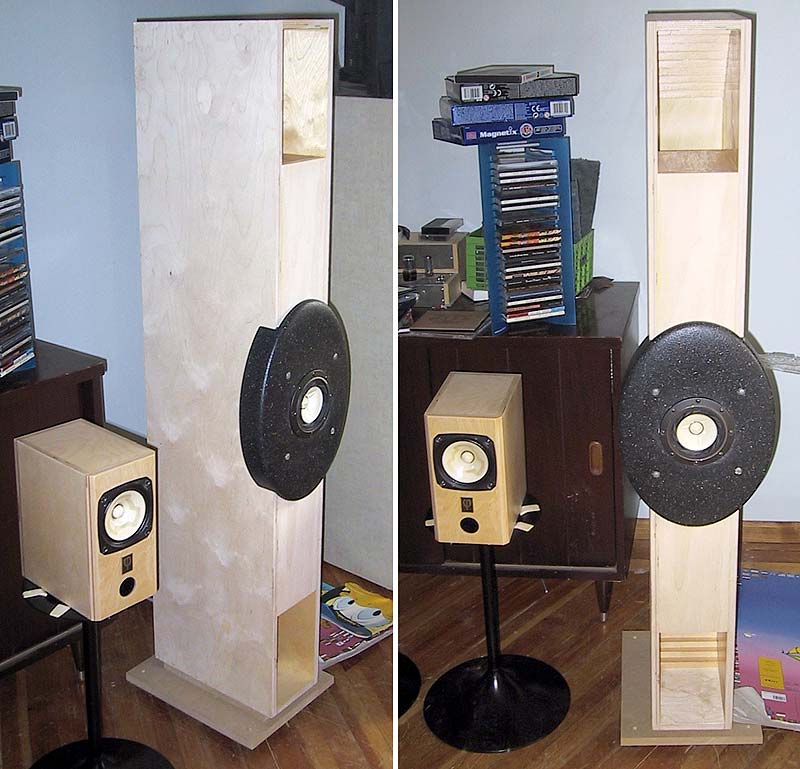
For the FE126 Austin, A126, Kongo, Valiant, Frugel-Horn Mk3 is on the edge to support them, corners are usually recommended. FE108e∑ probably also works in all the above. We haven’t tried them. Scott?
dave
FE126En & FE126NV are close enuff thta they work in the horn as well.
I would say the FE108e∑ is an overall upgrade to FE126, it won't play as loud, is not as sensitive, but smooth and a glorious midrange. The best horn we have fiound for the Sigma is Aiko.

For the FE126 Austin, A126, Kongo, Valiant, Frugel-Horn Mk3 is on the edge to support them, corners are usually recommended. FE108e∑ probably also works in all the above. We haven’t tried them. Scott?
dave
Thanks Dave.
The Madisound BK12 and BK16 to me are real horns, that is, expanding gradually. Not really but good enough (I mean, there are short segments with an given angle and then a next one expanding more; ideal would be a shorter increment, but that is on paper and some CNC designs like Concerto/Concertino nowadays.
Looking at the design Fostex made for the FE108Sigma it is quite different:

My question is, does it give a different listening experience? Ample bass is one; picking out small bands of tones is another thing.
parallel sides stock design
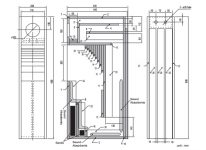
Now this BL-108 version looks more promising: expanding:
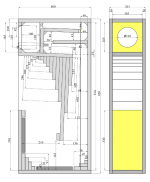
here is the impedance curve of the stock parrallel-sides "Fostex BK108" measured in a German magazine. It shows a series of three or four impedance bumps.
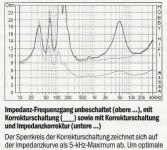
The Madisound BK12 and BK16 to me are real horns, that is, expanding gradually. Not really but good enough (I mean, there are short segments with an given angle and then a next one expanding more; ideal would be a shorter increment, but that is on paper and some CNC designs like Concerto/Concertino nowadays.
Looking at the design Fostex made for the FE108Sigma it is quite different:
- a series of chambers
- parallel walls
- and when one fills in the bends (the corners) to make a smooth transition, the sound falls apart
- So - they are [IMHO] resonance chambers.
My question is, does it give a different listening experience? Ample bass is one; picking out small bands of tones is another thing.
parallel sides stock design

Now this BL-108 version looks more promising: expanding:

here is the impedance curve of the stock parrallel-sides "Fostex BK108" measured in a German magazine. It shows a series of three or four impedance bumps.

if you want to see an air cavity horn with a fairly even flare di look at Austin A126. We built it, it is tremendous. A friend has them corner loaded with a 20 w NAD and the bass is overpowering. But he like it that way. He listens loud. He hasn’t broken them yet.
The Fostex recomended horns are derived from the many Nagaoka horns, and those are based on Harry Olson’s work and horns. At every step particualrily if at a fold, one gets an expansion in the pipe which acts as a low pass filter.
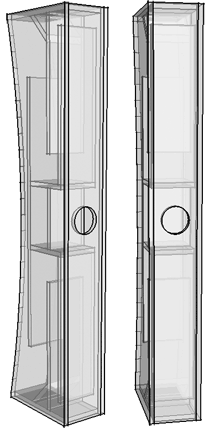
With a back loaded horn, one does not want any higher frrequencies coming out.
Tapered horns use the basic math from front loaded horns and making them really smooth actually degrades them.
Consider the horn mouth. The basic math has a circular horn mouth. The circumference is about 1 wavelength of the lowest frequencies the horn will reproduce. A square is close so you can use the perimeter. That is if it is hanging in midair. If we put it on the ground/floor, we can get away with half that (plane morrors the mouth). Into a wall/floor interface a forth, facing into a corner an eight.
So BK-12 is half, FH3, Austin A126, Valiant are a forth, an eigth if you can push it into a corner. That may well be too much with the last 2.
The impedance peaks you see in that response are characteristic of an undamed TL, which is what you get when the horn is foreshortened (almost all of them).
As a rectangualr horn’s aspect ratio increases beyond a certain point, the circumeference?LF cutoff relation starts to get stretched. The curved mouths you see on these is too make the mouth look more like an ideal circle.
Everything has tradeoffs. Lots of them when you design a horn.
dave
The Fostex recomended horns are derived from the many Nagaoka horns, and those are based on Harry Olson’s work and horns. At every step particualrily if at a fold, one gets an expansion in the pipe which acts as a low pass filter.

With a back loaded horn, one does not want any higher frrequencies coming out.
Tapered horns use the basic math from front loaded horns and making them really smooth actually degrades them.
Consider the horn mouth. The basic math has a circular horn mouth. The circumference is about 1 wavelength of the lowest frequencies the horn will reproduce. A square is close so you can use the perimeter. That is if it is hanging in midair. If we put it on the ground/floor, we can get away with half that (plane morrors the mouth). Into a wall/floor interface a forth, facing into a corner an eight.
So BK-12 is half, FH3, Austin A126, Valiant are a forth, an eigth if you can push it into a corner. That may well be too much with the last 2.
The impedance peaks you see in that response are characteristic of an undamed TL, which is what you get when the horn is foreshortened (almost all of them).
As a rectangualr horn’s aspect ratio increases beyond a certain point, the circumeference?LF cutoff relation starts to get stretched. The curved mouths you see on these is too make the mouth look more like an ideal circle.
Everything has tradeoffs. Lots of them when you design a horn.
dave
The explanation of the tube segments as low pass filters is great; it is not an array of organ pipes.
Revived old thread, with info on the Fostex 108 E Sigma. In a BK108 house, the Eckhorn.
see https://www.diyaudio.com/community/threads/diy-sony-vfet-pt-1.370282/post-7220260
I ventured for a ready built horn. [and due to Covid I did not listen].
The bass is little but smooth, no pronounced parts.
the Eckhorn can come with a filter (0,39mH//12ohm//4,7 uF) to reduce the high midtone a few dB. But I did not like that filter because it still was nasal, and started my own, 0,55mH//5,1ohm//0,1uF) that was neither good but at least smoother. No good high end of course.
After feedback I was urged to make the step filter into a real bandpass filter. Due to what is in my toolbox, I have on hand 0,39mH//5,5ohm//10 uF. That sounds great, although the high could be slightly more recessed (that is, the 5,5 could be 4,7 or lower, just a small change).
Dave/Planet10 suggest to ‘close the gap’ between dome and cone. Fostex came with a 3-point suspension, and in the frequency plot you can see the two change phase around 3 kHz. Visually bad bad. So it could help smoothen the sound, even get the lift in the upper mid out, so a band-pass dilter is not needed. Will I experiment? No.
The BK108 Eckhorn & Fostex 108eSigma is also sold with a digital equalizer. Of course it works - but that is cheating, sort of.
Revived old thread, with info on the Fostex 108 E Sigma. In a BK108 house, the Eckhorn.
see https://www.diyaudio.com/community/threads/diy-sony-vfet-pt-1.370282/post-7220260
I ventured for a ready built horn. [and due to Covid I did not listen].
The bass is little but smooth, no pronounced parts.
the Eckhorn can come with a filter (0,39mH//12ohm//4,7 uF) to reduce the high midtone a few dB. But I did not like that filter because it still was nasal, and started my own, 0,55mH//5,1ohm//0,1uF) that was neither good but at least smoother. No good high end of course.
After feedback I was urged to make the step filter into a real bandpass filter. Due to what is in my toolbox, I have on hand 0,39mH//5,5ohm//10 uF. That sounds great, although the high could be slightly more recessed (that is, the 5,5 could be 4,7 or lower, just a small change).
Dave/Planet10 suggest to ‘close the gap’ between dome and cone. Fostex came with a 3-point suspension, and in the frequency plot you can see the two change phase around 3 kHz. Visually bad bad. So it could help smoothen the sound, even get the lift in the upper mid out, so a band-pass dilter is not needed. Will I experiment? No.
The BK108 Eckhorn & Fostex 108eSigma is also sold with a digital equalizer. Of course it works - but that is cheating, sort of.
- Home
- Loudspeakers
- Full Range
- Fostex FE 126En